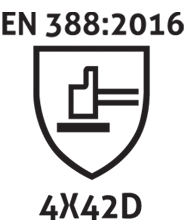EN 388 is the standard for gloves designed for protection against mechanical risks, and covers resistance to abrasion, cut, tear, puncture, and impact. The below pictogram is used to claim protection from any of the mentioned mechanical risks – the letters A to F in the example would indicate the performance levels for different tests (explained below) on a glove stamp. A ‘0’ displayed under the pictogram indicates the glove did not meet the minimum requirements for the test, and an ‘X’ indicates a test was not carried out or is not applicable (this is slightly different for the impact resistance test – see section F).


A – Abrasion resistance: this test uses a Martindale test machine to abrade circular specimens taken from the palm of each of four gloves against a specified 180 grit abrasive paper. The abrasion resistance performance level is determined by the number of rubs required to form a hole all the way through any of the four specimens (see table below).
| Performance level | 1 | 2 | 3 | 4 |
| Abrasion resistance (rubs) | 100 | 500 | 2000 | 8000 |
B – Cut resistance (Coup test): this test involves using a counter-rotating circular blade of specified sharpness to perform alternating cuts on a cotton canvas reference material and a specimen taken from the palm of a glove. The blade travel distance is measured in cycles, and the difference between the number of cycles to cut through the canvas material and the test specimen is used to calculate the cut index. Two specimens are tested from two different gloves, and the lowest average cut index is used to assign a performance level from the table below.
If the blade is shown to be blunted by the glove material at any point during the test, the ISO 13997 test method (see section E) should be used instead.
| Performance level | 1 | 2 | 3 | 4 | 5 |
| Cut resistance (Coup test) (index) | 1.2 | 2.5 | 5.0 | 10.0 | 20.0 |
C – Tear resistance: tear resistance is defined as the peak force in Newtons required to completely tear a trouser-shaped specimen cut from the palm of a glove. Four specimens are tested from four different gloves, and the lowest result is used to assign a performance level from the table below.
| Performance level | 1 | 2 | 3 | 4 |
| Tear resistance (N) | 10 | 25 | 50 | 75 |
D – Puncture resistance: puncture resistance is defined as the peak force in Newtons required to drive a stylus through a specimen cut from the palm of a glove. Four specimens are tested from four different gloves, and the lowest result is used to assign a performance level from the table below. Note that this test does not cover risk of needlestick injuries – the stylus is ~4.5 mm wide and of similar sharpness to a ballpoint pen.
| Performance level | 1 | 2 | 3 | 4 |
| Puncture resistance (N) | 20 | 60 | 100 | 150 |
E – Cut resistance (ISO 13997): this test (also referred to as ‘TDM cut resistance’, due to the use of a TDM-100 test machine) involves passing a straight blade of known sharpness across a specimen taken from the palm of the glove with the blade placed under varying loads by adding or removing weights. The distance the blade travels before cutting through the specimen under each load is recorded. A new blade is used for each cut, and cuts are repeated until 5 cuts have been obtained in each of the following distance ranges: 0 – 15 mm, 15 – 30 mm, and 30 – 50 mm. The load and distance results are plotted on a graph and used to estimate the load in Newtons required to produce a cut distance of 20 mm. Five cuts are then performed using this load, and the estimate is recalculated to provide the final load estimate. Performance levels are assigned based on the final estimate according to the below table:
| Performance level | A | B | C | D | E | F |
| Cut resistance (ISO 13997) (N) | 2 | 5 | 10 | 15 | 22 | 30 |
F – Impact resistance: this test involves dropping a weight resulting in an impact energy of 5 J on the area claiming impact resistance and measuring the transmitted force. The impact resistance test is optional, with a pass result indicated by a ‘P’ under the pictogram. Unlike the other EN 388 tests, an ‘X’ does not need to be displayed under the pictogram if this test was not conducted.
| Impact attenuation resistance | Pass/Fail |
| Single result | ≤ 9.0 kN |
| Mean transmitted force | ≤ 7.0 kN |


Example glove stamp - the glove achieved level 4 abrasion, Coup cut resistance was not tested, level 4 for tear resistance, level 2 for puncture resistance, and level D for ISO 13997 cut resistance.
Need More Advice on Standards and Compliance?
